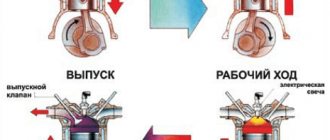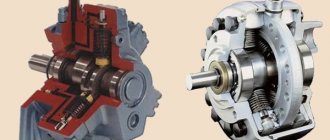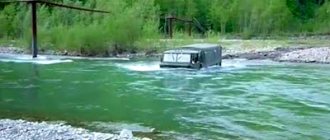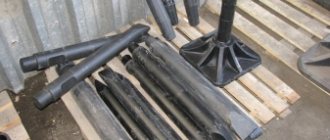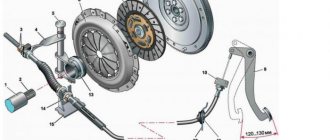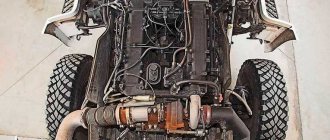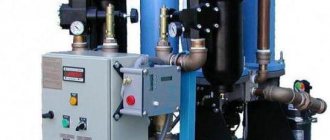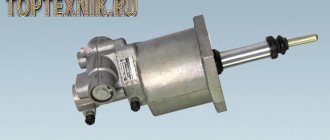Turbine design and features
The unit consists of two devices - a turbine and a compressor. The task of the first is to convert the energy of exhaust gases, and the second is to supply compressed air to the cylinders. “Impellers” are the main components of this system; they represent two bladed wheels (compressor and turbine).
At its core, a compressor is a pump; its only task is to supply compressed atmospheric air masses to the cylinders. Oxygen is necessary to burn fuel; the more it is supplied, the more the power unit can burn. As a result, this leads to a significant increase in engine power without physically increasing the volume or number of cylinders. The turbocharging system consists of the following components:
- compressor housing;
- turbine housing;
- bearing housing;
- compressor wheel;
- turbine wheel;
- rotor axis or shaft.
In a turbocharger, the main element is the rotor, which is protected by a housing and attached to a special axis. Both the rotor itself and the turbine housing are made of heat-resistant alloys - this is necessary due to the fact that they are in constant contact with high-temperature gases.
The rotor and impeller rotate in different directions at high speed - this solution ensures that they are pressed tightly against each other. The operating principle is as follows:
- Exhaust gases enter the exhaust manifold.
- Then - into a special channel located in the supercharger housing, which is made in the shape of a snail.
- In the “snail” the gases are accelerated to high speed and supplied to the rotor.
Thanks to this principle, the rotation of the turbine is ensured. As for the turbocharger axis, it is mounted on special plain bearings and is lubricated by the flow of fluid from the engine compartment. Leakage of lubricant is prevented by the presence of a gasket and O-rings. In addition, mixed and separate flows of exhaust gases and air provide additional sealing. This technological solution does not provide a 100% guarantee that the exhaust will not enter the compressed air, but the system does not require this.
or call back 7 (921) 932-25-54
What else is included in the turbocharging system?
The turbine is a complex unit; it took engineers several decades to perfect the system. Only at first glance, the solution to compensate for efficiency losses using exhaust gases seems simple. Even after the creation of the device, it had certain problems for a long time.
For example, it was not possible to solve the problem of turbo lag - a delay after pressing the gas pedal and starting the rotor. The solution was found in the form of using two valves. One of them was used to remove excess air, and the second was intended for exhaust gases. In addition, modern turbines have a modified blade geometry, which seriously distinguishes them from similar devices of the second half of the 20th century.
One more problem can be identified, which was excessive detonation - modern engineers have also successfully dealt with this. The problem was that the temperature in the working sectors of the cylinders increased sharply during air injection, especially in the last stage of the stroke. The solution was found in installing an intercooler (air intercooler).
Intercooler is a device for cooling charge air. It performs two functions at once - it prevents detonation and prevents air density from decreasing. As a result, it was possible to maintain the functionality of the entire system.
It is also worth noting other important components of the turbine.
Control valve. Responsible for maintaining a given pressure level; excess pressure enters the exhaust pipe.
Bypass valve. It is used to remove excess air masses back into the intake pipes - this is necessary to reduce power when there is excess power.
Bleeding valve. If the throttle closes and there is no MAF sensor, the valve will return excess air back to the atmosphere.
Pipes. Sealed pipe sections. Some are used to supply air, the other to supply lubricating oil.
Exhaust manifolds. Must be compatible with turbocharger.
Principle of operation
First you need to understand two terms.
Turbo boost is a condition in which a rapidly rotating rotor increases the air supply to the cylinders, thereby increasing the power of the power unit.
Turbo lag is a short delay that occurs in the operation of the turbine when the amount of fuel supplied increases while the gas pedal is pressed. The delay appears due to the fact that the rotor needs some time until the gases accelerate it.
Turbocharging increases exhaust gas pressure due to more intense engine operation, but at the same time the boost pressure also increases. When critical values are reached, breakdown may occur, and therefore this process must be controlled. Valves are responsible for regulating the pressure, and the membrane and spring monitor the maximum permissible values. When a certain value is reached, the membrane opens a valve to relieve pressure.
The operation of a turbine on a diesel engine requires pressure control, which is carried out by the following processes:
- if too much air has entered, the compressor (using a valve) is released from the excess;
- the valve relieves pressure in cases where too much air has entered - while the unit operates stably and takes in exactly as much air as required.
Trusted manufacturers
When choosing to install a gasoline or diesel turbine, it is recommended to choose original units. Although many turbine repairmen are skeptical about all types of turbines, noting their rapid wear and tear, the original turbines still meet their specifications, although manufacturers, setting their service life equal to the life of the engine, are being dishonest. These manufacturers include the following brands:
- IHI – USA; • Borg Warner – Germany; • Garrett – USA; • Holset – England.
Holset produces turbines with sliding blades, but the units are designed only for trucks.
If we talk about diesel engines, then for them the installation of a turbine is absolutely justified - it is no longer possible to imagine a car running on diesel fuel without a turbocharger system. If we consider gasoline engines, then choosing a standard naturally aspirated engine is in many cases preferable to installing a turbine. As an alternative, to increase the power of a gasoline unit, a compressor ( supercharger ) is often used instead of a classic turbine.
Add ProCrossovers to your favorites
Operation of a turbocharger on a diesel engine
The work is carried out according to the following scheme:
- The compressor pumps compressed atmospheric air.
- The air mass is mixed with fuel and enters the cylinders.
- The resulting fuel-air mixture ignites, which sets the pistons in motion.
- In parallel with this process, exhaust gases appear and are sent to the exhaust manifold.
- The gases accumulated in the housing significantly increase the speed.
- The rotation passes (along the shaft) to the compressor rotor, it draws in a new portion of air.
It turns out to be an interesting interaction. The rotor rotates faster - more air flows. The more air comes in, the faster the rotor rotates.
Compressor block
The part of the turbine through which atmospheric air is forced is called a compressor. Main components: housing (cold volute), rotor. The rotor is rigidly mounted on a common axis with the turbine impeller. When the first one rotates, the rotor wheel moves in the opposite direction. Due to the rotation of the aluminum rotor blades, the air is drawn in by a vortex flow, the air pressure increases due to the flow transition from the center of the rotor to its walls.
Double turbine is used on multi-cylinder blocks
An air filter installed at the inlet to the intake manifold prevents dirt, small debris, etc. from entering the turbine.
Disadvantages of a turbine on a diesel engine
Like any device, the turbine has its own positive characteristics (which were described above) and disadvantages. The disadvantages include, first of all, increased fuel consumption, especially for incorrectly adjusted units. The second disadvantage is sensitivity to fuel quality, which is especially important in Russian conditions. The fact is that low-quality diesel can lead to detonation. Let's note other disadvantages:
- general increase in engine cost;
- increased demands on motor oil;
- oil and filters have to be changed more often (approximately every 5-6 thousand km);
- you need to change the air filter often;
- The turbine life of a diesel engine is significantly lower than that of a gasoline engine (due to higher exhaust temperatures);
- the average resource of the unit is 200-250 thousand km, after which it will require replacement or, at a minimum, major repairs;
- The repair is quite complex, and the average car owner will not be able to carry it out on his own.
However, it is worth noting that the pros still outweigh the cons. Otherwise, turbines would not be so popular.
Myths about the oil filter
The size of the oil filter on the rally Peugeot 205 t16 group B is indicative.
Let us dispel the misconception of some motorists who say that timely replacement of the oil filter will prevent wear of the moving parts of the turbine. At the moment of a cold start, and also when the oil filter is clogged to its critical level, the filter safety valve opens slightly, and some of the oil always penetrates into the turbine system, as well as into the oil system of the entire power unit. The valve will remain half-open or fully open until the oil reaches its normal temperature. Thus, all foreign particles and suspensions that are in the oil will sooner or later end up in the turbine.
Main malfunctions - signs and causes
It’s worth mentioning right away that the main cause of breakdowns is untimely maintenance of the unit; it is recommended to carry it out at least once a year. The next reason is low quality oil or untimely replacement. The third is the entry of foreign objects into the device (for example, small pebbles). Finally, the fourth is the banal wear and tear of individual turbine components, because each equipment has its own service life. Now we will describe the signs that may indicate a malfunction.
Black smoke from the exhaust pipe. The fuel burns in the intercooler or charge line. Most likely there is a malfunction of the control system.
Blue smoke. Perhaps due to a failure in the turbine seal, oil leaks into the combustion chamber.
White smoke. The oil drain line is dirty and will need to be cleaned.
Increased fuel consumption. Air does not reach the compressor.
Increased oil consumption. It is necessary to check the joints of the pipes - the tightness may be broken.
Reduced acceleration dynamics. Most likely, the control system failed, causing a lack of oxygen.
Extraneous whistling, grinding or noise. This could be a change in the rotor clearance, a defect in the housing, an air leak between the engine and the turbine, or contamination of the oil line.
You should always follow the operating rules of the unit - this will reduce the likelihood of breakdowns and extend the life of the device. You should follow a few simple rules:
- monitor the quality of fuel and oil;
- do not forget to change the oil and filters on time;
- start driving only after the engine has warmed up;
- After stopping movement, you need to let the engine idle, and not immediately turn it off.
And, of course, you should undergo regular maintenance.
Operating rules
In order to fully use the resource of a diesel engine turbine and extend its service life, a number of conditions must be met:
- Change the oil in the system regularly to prevent abrasive from getting into the oil line and clogging it.
- Use only high-quality certified oil of the brand that corresponds to that specified in the engine data sheet.
- Warm up the engine before driving and do not put high loads on a cold engine.
- Never suddenly turn off the engine, and after stopping the car, give it the opportunity to idle for a few seconds.
What to do if the turbine breaks down
If a malfunction is detected, the first thing to do is carry out diagnostics. And the sooner the better. If you replace a faulty part in time, you will be able to avoid more serious problems. For example, often a car owner does not pay attention to a slight knocking, thinking that it does not matter; as a result, after some time he has to buy a new turbine, although initially a minor repair could have been done.
It should be noted that it is not enough to know how a diesel turbine works - you need to have a perfect understanding of all its components. Only with the appropriate skills, experience and equipment will it be possible to carry out high-quality repairs. That is why we recommend that you do not try to repair the unit yourself (you can only make it worse), but contact. We have been specializing in turbine repair since 1998, and therefore we know everything about them.
5 reasons to contact us:
- High-precision diagnostic equipment is available (Bosch and Delphi stands);
- The staff includes specialists with extensive practical experience in such work.
- Quick repairs within a day without loss of quality.
- We use only original components and repair kits.
- We provide an official guarantee on components and repairs performed.
At the first sign of a defect, contact us. We will determine the cause of the problem and offer an effective, cost-effective way to solve it.
Why you can’t do repairs yourself
This operation cannot be done by hand. An automobile turbine operates at very high speeds and temperatures, so the demands placed on it are very high.
The system must be sealed and the entry of any small foreign objects into it during repairs or maintenance is unacceptable. Special equipment and skills are required to disassemble and assemble the turbine.
The room in which these operations are carried out must be as clean as possible; the ingress of dust and other substances onto the parts of the turbine installation can entail large financial costs. Specialists from specialized service centers have a precise understanding of how to check the operation of the turbine.
